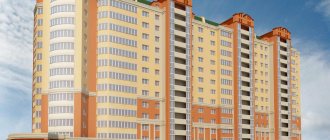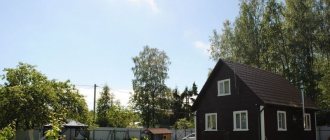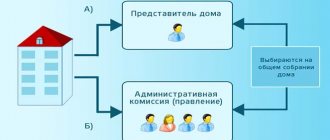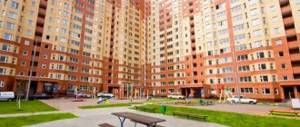Interpretation of an apartment building in the Housing Code
From a legal point of view, an apartment building is a building containing two or more apartments with access to common areas or to the territory of a land plot adjacent to the apartment building.
Attention! If you have any questions, you can chat for free with a lawyer at the bottom of the screen or call Moscow; Saint Petersburg; Free call for all of Russia.
For your information
According to clause 3, article 16 of the Housing Code of the Russian Federation, an apartment is considered a separate area consisting of living rooms and auxiliary premises intended to satisfy household needs.
In the Housing Code of the Russian Federation, namely in paragraph 1, article 36, an apartment building is considered as real estate in common shared ownership. At the same time, in addition to the square meters indicated in the Certificate, the owners of the premises own:
- premises not related to apartments and involving common use (staircases, basements, attics, technical rooms, elevators, etc.);
- premises intended for holding cultural events and organizing leisure activities for owners of apartment building real estate;
- roofs, engineering structures and equipment located both inside and outside the house;
- the land plot on which the apartment building is built, and the objects located on this plot.
The share of ownership of common property is directly proportional to the area owned by a particular citizen (based on clause 1, article 37 of the Housing Code of the Russian Federation).
What work is the responsibility of the management company?
A management company is an organization that the owners of real estate entrust with the management of their shared ownership property in accordance with the Trust Management Agreement.
Important! The responsibilities of management companies are regulated by the Housing Code of the Russian Federation, including articles No. 161 and 162.
The management company operates on the basis of a concluded Agreement with the property owners and performs the following work:
- ensures the safety of living in the serviced building in accordance with the Fire Safety Rules and the requirements of sanitary and epidemiological standards;
- provides owners with access to real estate objects that are in shared ownership;
- maintains engineering equipment and general house metering devices installed on utility lines in working condition;
- carries out repairs of common property;
- carries out general management of the activities of the MKD.
Responsibilities of the management company for the maintenance of apartment buildings
All work performed by the management company can be classified as follows:
- maintenance of common property and servicing the current needs of homeowners (garbage removal, energy supply, etc.);
- current and major repairs of common property.
The legislative framework
There are several legislative acts that define the procedure for establishing the status of an apartment building and regulating the rights of owners of premises located in it:
| Title of the document | Its essence |
| Government Decree No. 47 of January 20, 2006. | A legislative act establishing the basic requirements for residential premises. |
| Town Planning Code | A set of laws defining the procedure for territorial planning, design and construction of buildings. |
| SNiP 01/31/2003 | A set of rules containing the basic requirements for apartment buildings. |
| Government Decree No. 491 of 08/13/06. | An act regulating the maintenance of common property in apartment buildings. |
| Government Decree No. 290 of 04/03/13. | A document containing a list of the minimum services necessary to maintain the functionality of the property in the apartment building. |
| Resolution of the State Construction Committee of the Russian Federation No. 170 dated September 27, 2003. | A legislative act containing the rules and regulations for the technical operation of residential premises. |
| Government Decree No. 416 of 05.15.13. | A legal act that defines management standards for apartment buildings. |
Types of apartment buildings
Apartment building is a concept that generalizes several types of buildings, classified according to the following criteria:
- By purpose:
- apartment buildings intended for permanent residence;
- hostels intended for temporary or permanent residence.
- By number of floors:
- low-rise (reaching two floors);
- mid-rise (houses from three to five floors in height);
- multi-storey (more than six floors);
- high-rise buildings (from 11 to 16);
- high-rise (more than 16 floors).
- By number of apartments:
- semi-detached;
- multi-apartment
- By structure:
- corridors (entrance to apartments from a common corridor);
- sectional (several apartments with access to one common room);
- gallery;
- blocked;
- mixed type.
- According to the materials from which the fundamental structures are made:
- brick;
- panel;
- monolithic;
- mixed type (stone or concrete walls with wooden floors).
IMPORTANT
The service life of the building directly depends on the materials of the supporting structures. Panel houses can last 100-120 years, while monolithic and brick houses can last up to 150 years.
Requirements for apartment buildings
The basic requirements for apartment buildings are specified in the set of rules SNiP 31-01-2003, introduced on May 20, 2011. The regulations apply to the design and construction of apartment buildings and include requirements for:
- location of the building;
- communications installed inside the building;
- altitude;
- apartments and common areas;
- activities of an organization located in the commercial premises of a residential building;
- load-bearing structures, etc.
Please note:
This legislative act does not apply to blocked buildings or mobile buildings.
What is an apartment building council?
The council of an apartment building is an elected body that is not a legal entity and is elected by a general meeting of homeowners. The responsibilities and functions of the MKD council are determined by the RF Housing Code; they can be formulated as follows:
- Monitoring the activities of the management company.
- Coordination of the activities of the management company and identification of priority activities required for implementation.
- Review and approval of estimates for major and current repairs.
- Studying and drawing up proposals for improving service by energy supply and other organizations providing services for the maintenance of apartment buildings.
The role of the MKD council in monitoring the work of the management company
For your information! The council of an apartment building must draw up a plan for its work for the year, after which it reports on the work done at the general meeting of homeowners.
A chairman is elected from among the members of the council of the apartment building, who is vested with certain powers, expressed in his rights and responsibilities.
Rights of the chairman of the MKD:
- signs certificates of work performed at MKD facilities;
- signs reports of violations identified in the work of the management company and other organizations providing MKD services;
- resolves issues with the administration of the region where the MKD is located in case of violations of the activities of the management company.
Responsibilities of the Chairman of the MKD:
- manages the activities of the MKD council;
- negotiates with the management company on issues of cooperation and provision of services;
- acts on behalf of homeowners in various administrative bodies when drawing up the appropriate power of attorney.
Powers of the chairman of the MKD
All issues related to the activities of the management company, the board and the chairman of the MKD can be resolved by knowing the relevant regulatory documents, as well as having experience in resolving legal issues. Therefore, if difficulties and problems arise in this area of life of a modern person, it is best to seek help from a qualified lawyer working in the housing and communal services sector.
Differences between a private house and an apartment building
According to clause 3, article 48 of the Town Planning Code of the Russian Federation, a private house (or an individual construction project) is a building consisting of no more than three floors and intended for one family. Hence, one of the obvious differences between an apartment building and a private house is the number of floors (apartment buildings are not limited by law in the number of floors). In addition, apartment buildings are designed to accommodate a larger number of families that are not related to each other.
For your information
Another fundamental difference between the objects under consideration is the presence of common property in apartment buildings. Private buildings, as a rule, do not have common staircases, elevators and technical premises, and the land plot on which the building is located belongs to one or several owners.
The definition of an apartment building presupposes the presence of a management company, homeowners association or cooperative. Owners of a private house pay exclusively for utilities, without making contributions for the current maintenance of the housing stock, major repairs, etc.
Low-rise formats
For general development and understanding, let’s take a closer look at the issue of classifying low-rise buildings
Apartment house
- standardly has from 2 to 4 floors, sometimes the height of the building reaches 6 flights of stairs, usually one or two entrances, less often there are 3-4 sections, an architectural structure with a lightweight engineering system, a distinctive feature of a low-rise apartment building - lack of elevator and garbage chute.
Townhouse
- a low-rise residential building or public building up to 3 floors high with several multi-level apartments, usually with isolated entrances, that is, without a common entrance. In elite townhouses there are no more than 4-6 equal sections, in ordinary ones the number of apartments identical in layout ranges from 12 to 16. Each townhouse apartment has, but not necessarily, a separate entrance from the street, sometimes a garage and a small front garden/small plot of land. The main difference between a townhouse and a duplex is the number of sections.
Duplex
- a low-rise residential building most often has 2 floors with multi-level apartments for only two families; the building is divided into two equal halves and has separate entrance areas.
The fundamental significant difference in low-rise buildings lies in their location, where exactly the house is located - inside the city or outside its boundaries. But be that as it may, a proper low-rise building, built according to all the canons, in compliance with all urban planning, legal norms and technical requirements, with all the necessary permitting documentation, should bring its owners mostly positive emotions, although there is a fly in the ointment in this matter, of course it is present. At the beginning, to present the completeness of the picture, we will take a closer look at all the positive and negative aspects, all the pros and cons, advantages and disadvantages of apartments in low-rise buildings outside the city:
Blocked apartment building
According to paragraph 2, paragraph 2, art. 49 of the Town Planning Code of the Russian Federation, a block-built house is a building, no more than three floors in height, consisting of separate blocks (each intended for the residence of separate families), having common walls without openings between the blocks and access to a common area.
Additional Information
A blocked building is a house with a separate exit from each apartment directly to a public plot of land. A distinctive feature of such a property is the registration in the cadastral register of each block (apartment) separately, with the adjacent territory.
Attention
This type of real estate does not belong to the MKD, which means it is not included in the projects of regional programs and is maintained at the expense of the owners of the premises (by analogy with a private house).
Is it possible to change the status of the house?
Often, after the addition of additional structures or the demolition of part of the building, the status of the object can be changed (with the consent of all owners of the premises located in the building). The following documents become the basis for applying to local authorities:
- A plan of a residential building containing a technical description of the object, drawn up on the basis of a construction permit and design documentation.
- A plan of a residential building with a technical description of the object and drawn up in strict accordance with the passport of the premises (if the latter was built after the adoption of the Town Planning Code of the Russian Federation).
- A house plan with a description, drawn up in accordance with the declaration and a judicial act recognizing the ownership of an unauthorized construction (if the object was erected in violation of the Town Planning Code).
- A house plan with a technical description, drawn up on the basis of the declaration, if other documents are missing or lost beyond the possibility of recovery.
IMPORTANT
A change in the status of a residential building entails changes in the rights and responsibilities of the owners of the premises, as well as in the way the property is managed.
Is a dormitory and a semi-detached house an apartment building?
In 2021, for most citizens the question of whether a two-apartment residential building is multi-apartment building remains relevant.
The concept of an apartment building is defined in Decree of the Government of the Russian Federation No. 47 “On approval of the Regulations on recognizing premises as residential premises, residential premises unsuitable for habitation and an apartment building as unsafe and subject to demolition or reconstruction.”
In accordance with the above-mentioned document, an apartment building is a collection of two or more apartments that have independent exits. Therefore, such a two-flat house is considered multi-apartment .
Regarding the question of whether a dormitory is an apartment building, it should be understood that only privatized rooms of a former dormitory after reconstruction can be classified as buildings that are called apartment buildings.
Dorm rooms make up the residential sector; these are apartment building facilities . Thus, in order for the hostel to turn into an apartment building, inventory and reconstruction are needed. After this, you need to change all addresses and reissue documents.
Features of MKD
Apartment buildings differ from other residential buildings and have a number of features:
- Residential and commercial premises located in an apartment building cannot remain without an owner, therefore contributions for current and major repairs, ODN are charged in any case.
- This type of real estate is characterized by a large number of premises owners who are required to bear responsibility not only for personal property, but also for the maintenance of premises and public structures.
- Due to the fact that all communications are centralized, it is simply impossible to limit resource consumption to an individual apartment. Therefore, the punishment of debtors may consist solely of turning off electricity.
- Inadequate control over resource-providing communications leads to disruptions in the supply of utilities for many premises users.
- Due to the large number of residents, conflict and disputable situations between owners are not uncommon, and they arise due to violation of the daily routine, seizure of public territory, etc.
- MKD, like any real estate object, is subject to wear and tear. That is why, over time, more and more money is spent on its maintenance and ongoing repairs.
- Apartment buildings require the mandatory presence of a management organization that controls the timely and full supply of necessary resources, the technical condition of all structures and communications, and proper care of the adjacent land plot.
- Unlike semi-detached houses and private residential properties, MKDs participate in federal and regional programs, which means that capital repairs, reconstruction or restoration are financed not only from the owners’ money, but also from budget funds.
Comments Showing 0 of 0
Conditions of maintenance of a residential building
You should familiarize yourself with this issue in more detail, since many residents of multi-storey buildings are not entirely aware of their immediate civic responsibilities. Citizens must do the following:
- Properly treat lighting in hallways, attics, as well as storerooms and technical buildings, elevators.
- It is imperative to monitor humidity and temperature levels in a timely manner.
- Promptly clean premises that belong to the common property of residents of apartment buildings.
- Take care of the timely removal of garbage, including accumulations from tenants who rent separate rooms in the house or in its adjacent territory.
- It is extremely important to observe fire safety and call service personnel if necessary.
- Ensure proper care of plants located in the local area, parking lots and other objects.
- Carry out comprehensive control of the apartment building in which citizens live.
- Carry out the necessary seasonal work in the local area that belongs to the building.
IMPORTANT! As a rule, residents themselves are not able to fulfill all these conditions for maintaining a residential building, which is why they make contributions for major repairs, and everything related to maintaining the building in proper conditions is transferred to the management company (housing and communal services or other partnership).
Responsibility for repairs
Property that is owned by all residents of an apartment building, like any other property, periodically requires timely repair procedures. If citizens have signed an agreement with the management company , then they undertake to make the required contributions in a timely manner, and also to include in the sample agreement the frequency of repairs and other work.
Provided that management of the building is transferred to the partnership , then issues regarding the order and frequency of repair and inspection work must be resolved at the relevant meetings, which, in turn, must be open and properly recorded. Especially when it comes to the need to make contributions and their purpose.
All repair and inspection work is carried out at the agreed time; if the management company is involved in this, then it undertakes to notify the residents of the house in advance of its intentions. But this does not apply to emergency situations, which are eliminated immediately as they arise (water pipe break, power outages, etc.).
IMPORTANT! All common property, equipment and other objects cannot have one specific owner; they are listed on the balance sheet of all residents. In addition, it should be noted that the entire list of these objects is regulated by the present legislation of the Russian Federation, and not by someone else’s decision.
Expenses
All objects that are part of the common property of residents of apartment buildings sooner or later need diagnostics or repair. This raises the question, who undertakes to cover the costs? According to the current rules of law, this responsibility falls directly on the owners of apartments and citizens who are registered in them. The full amount for major repairs will not be required from citizens immediately; it is usually formed as follows:
- Residents pay rent monthly, which additionally includes a contribution for major home repairs.
- Providing membership fees to the house maintenance fund, provided that there is no agreement with the management company, and all necessary work is entrusted to the partnership.
REFERENCE! It is worth noting that if one of the residents does not pay fees for major repairs, then he is recognized as a debtor, and subsequently may face liability under the current legislation of the Russian Federation.




